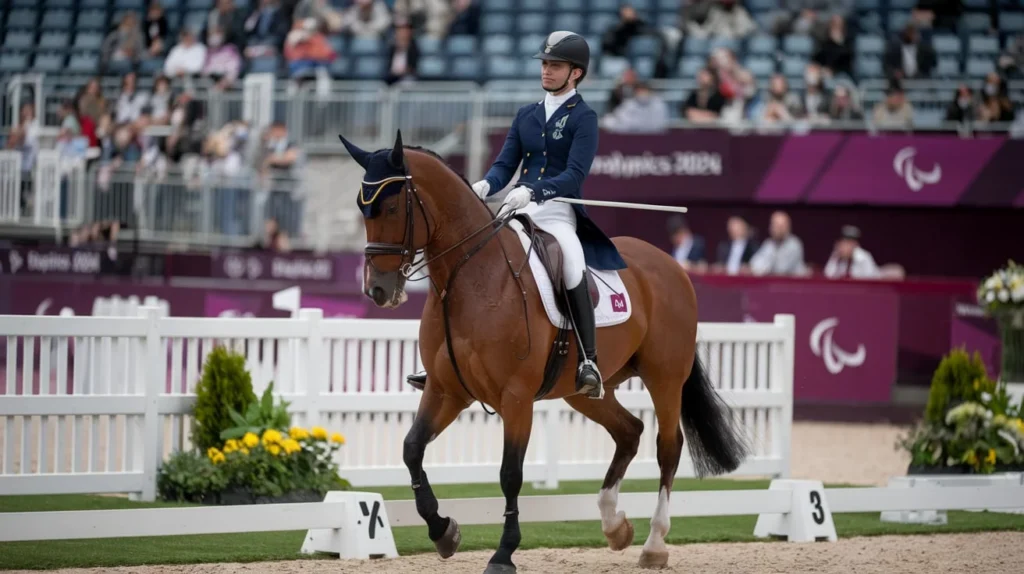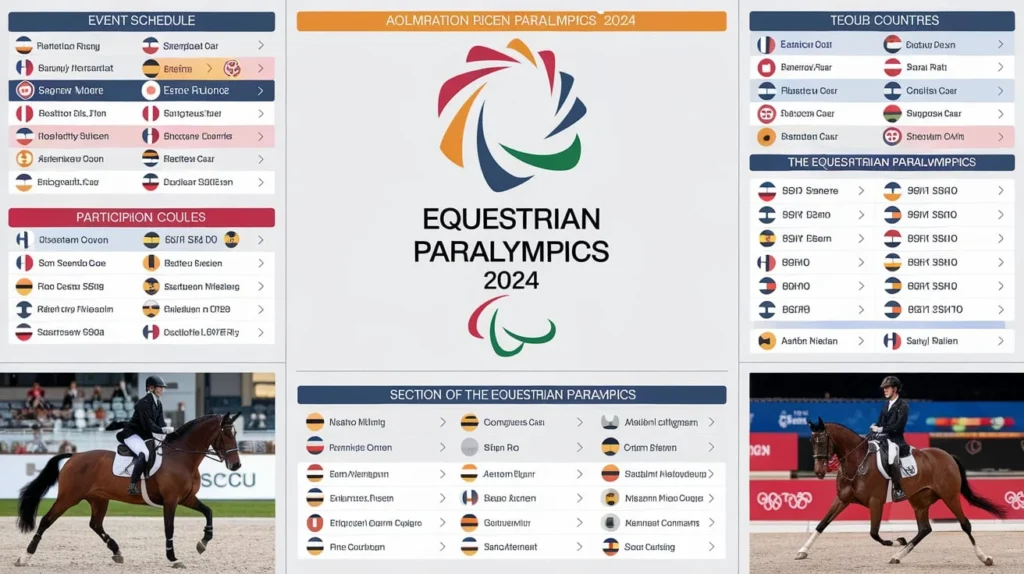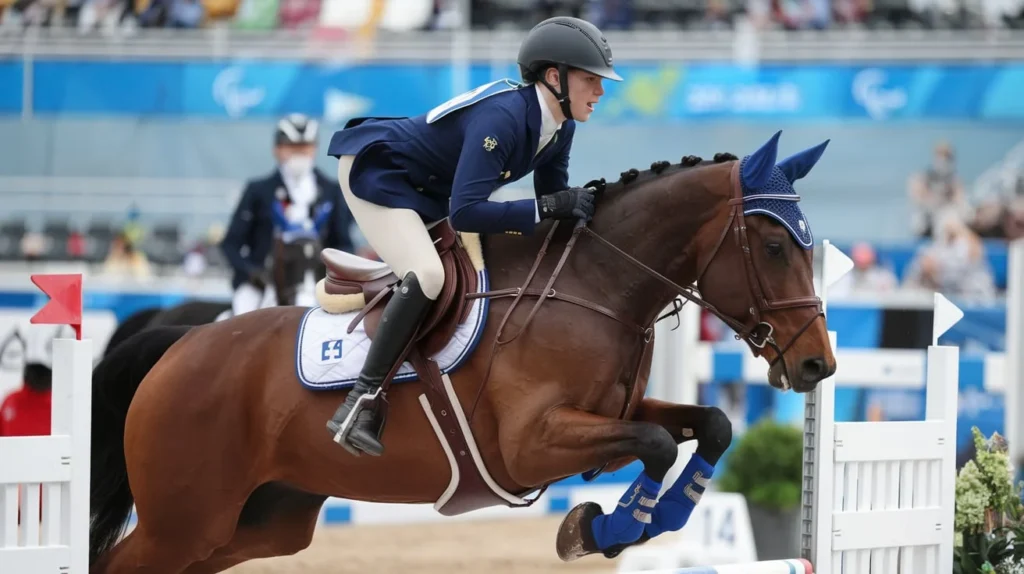The Equestrian Paralympics 2024 represented a landmark moment in adaptive sports, celebrating the skill, dedication, and resilience of athletes with physical disabilities. The Games brought together riders from around the world, each showcasing their partnership with horses in a display of athleticism and artistry.
Para dressage, the featured equestrian discipline, challenges riders to perform intricate movements with precision and grace. Each routine highlights the harmony between horse and rider, demonstrating not just physical ability but also trust, communication, and discipline.
Beyond the competition, the 2024 Paralympic equestrian events emphasized inclusivity and innovation in sports. From adaptive equipment to tailored training methods, the Games highlighted how adaptive riding enables athletes to reach their full potential while inspiring audiences globally.
What is Paralympics: A Celebration of Inclusive Sports
The Paralympics are the premier international multi-sport event for athletes with physical, visual, and intellectual impairments. It runs parallel to the Olympic Games, showcasing extraordinary talent, resilience, and determination. Since its inception in 1960 in Rome, the Paralympics has grown into a global movement, promoting inclusivity and equal opportunity in sports.
The Games feature a wide range of adaptive sports, including para athletics, swimming, wheelchair basketball, and para equestrian events. Each competition is designed to highlight the unique abilities of athletes while maintaining fairness through detailed classification systems. Beyond medals and records, the Paralympics inspires millions worldwide by breaking barriers and redefining the meaning of athletic achievement.
History of Equestrian in the Paralympics
Equestrian events made their Paralympic debut in 1996 at the Atlanta Games, introducing the world to the competitive and artistic sport of para dressage. This inclusion marked a major milestone for adaptive sports, offering athletes with physical impairments a platform to demonstrate skill, precision, and athleticism on a global stage.
Since 1996, para dressage has been a regular feature in every Paralympic Games, continuously evolving in classification systems, competition rules, and global participation. The 2024 Paris Games carried forward this rich legacy, celebrating more than two decades of para equestrian achievements and inspiring a new generation of riders worldwide.
Classification System and Rules

Para dressage uses a structured classification system to ensure fair competition among athletes with varying physical impairments. Riders are categorized into grades based on their functional abilities, allowing athletes with similar levels of impairment to compete against each other. The sport follows the core rules of traditional dressage but includes adaptive techniques and equipment to meet individual needs. Key aspects include:
Para-Equestrian Classifications
- Grade I: Riders with the most severe impairments affecting all limbs and trunk.
- Grade II: Athletes with moderate impairments, often with limited trunk control.
- Grade III: Riders with less severe impairments, able to maintain balance and perform more complex movements.
- Grade IV: Athletes with minimal impairments, competing at near-standard dressage levels.
Adaptive Rules and Equipment
- Use of specialized saddles and reins for better control and comfort.
- Permission for mounting assistance or support where necessary.
- Tests tailored to each grade, ensuring performance is measured fairly across all levels.
Notable Athletes to Watch in 2024
Several athletes captured attention at the 2024 Equestrian Paralympics with remarkable skill, determination, and consistency in para dressage competitions.
Fiona Howard (USA)
Competing in Grade II, Fiona Howard showcased exceptional harmony with her horse, Diamond Dunes. She secured a gold medal in the individual event, demonstrating precise movements, fluid transitions, and an inspiring connection between rider and horse.
Rebecca Hart (USA)
A seasoned para dressage competitor, Rebecca Hart excelled in Grade III, earning gold aboard her horse, Floratina. Her performance highlighted years of experience, discipline, and mastery of adaptive riding techniques, further solidifying her legacy in the sport.
Rihards Snikus (Latvia)
Rihards Snikus made history by winning Latvia’s first-ever Paralympic gold in para dressage. Competing in Grade I freestyle, Snikus displayed outstanding control and elegance, earning international recognition for both himself and his country.
Michele George (Belgium)
Veteran Michele George continued her dominance in the sport, adding two more gold medals to her collection at Paris 2024. With a total of seven Paralympic medals, her performances are a testament to consistency, skill, and enduring commitment to para equestrian excellence.
Adaptive Techniques and Training
Training for para dressage combines classical dressage methods with adaptations designed to support athletes’ individual physical abilities. Riders collaborate closely with trainers to develop personalized routines that enhance strengths and address limitations. Adaptive equipment plays a crucial role in ensuring effective communication and control between horse and rider, making precision and safety a priority. Key aspects of adaptive training include:
Adaptive Equipment
- Specialized Saddles: Designed to provide additional support and stability for riders with limited balance.
- Modified Reins: Allow riders with limited hand function to maintain control and signal commands effectively.
- Supportive Straps and Stirrups: Aid in mounting, balance, and secure positioning during routines.
Training Techniques
- Individualized exercises to strengthen rider-horse coordination.
- Focus on posture, balance, and timing to perform precise dressage movements.
- Incorporation of adaptive strategies to compensate for physical limitations without compromising performance.
Event Schedule and Venues
The para equestrian events at the 2024 Paris Paralympics took place at the iconic Château de Versailles, a UNESCO World Heritage site renowned for its historical and architectural grandeur. This majestic setting provided an inspiring backdrop for athletes and spectators alike, combining the elegance of dressage with the rich cultural heritage of France.
The competition spanned five days, from September 3 to 7, 2024, featuring a total of 11 events. These included ten individual competitions across Grades I to IV and one mixed team event, allowing nations to showcase their top riders. The schedule was carefully structured to balance individual and team performances while ensuring optimal conditions for both horses and riders.
Medal Predictions and Past Performances

Predicting medal winners in para dressage can be challenging due to the highly competitive and dynamic nature of the sport. However, historical performances and rider achievements often provide valuable insights into potential outcomes.
United States
The U.S. team has consistently been a powerhouse in para dressage, with athletes like Fiona Howard and Rebecca Hart leading the charge. Their skill, experience, and strong partnership with their horses made them top medal contenders at Paris 2024, and the results reflected their dominance.
Germany
Germany boasts a long-standing tradition in equestrian sports, producing elite riders with technical precision and consistency. The German para dressage team was expected to challenge for medals in multiple grades, leveraging decades of expertise in international competitions.
Great Britain
Great Britain has a rich legacy of para equestrian success, known for nurturing top para dressage talent. British riders consistently perform at a high level, and the 2024 Games were no exception, with their team competing strongly for podium finishes across several events.
Challenges and Innovations in Para-Equestrian Sports
Para equestrian sports face unique challenges, including the need for specialized training facilities, adaptive equipment, and support staff. Innovations in these areas have been crucial in advancing the sport.
For instance, the development of lightweight, adjustable saddles has improved comfort and performance for riders with varying physical needs. Additionally, advancements in classification systems have ensured fairer competition by more accurately grouping athletes based on their functional abilities.
Inspirational Stories from Athletes
The 2024 Equestrian Paralympics showcased not only skill but also the resilience and determination of remarkable athletes who overcame personal challenges to compete at the highest level.
Natasha Baker (Great Britain)
Returning as a new mother, Natasha Baker demonstrated extraordinary dedication by securing a bronze medal. Her performance highlighted her ability to balance motherhood with elite competition, proving that perseverance and passion can drive success on the world stage.
Katrine Kristensen (Denmark)
Katrine Kristensen also returned to the sport after becoming a mother and went on to capture a silver medal. Her journey illustrated the strength, focus, and adaptability required to compete at the Paralympics, inspiring fellow athletes and fans alike.
Conclusion
The Equestrian Paralympics 2024 highlighted the incredible skill, determination, and resilience of athletes competing in para dressage. From precise routines to inspiring stories of perseverance, the Games demonstrated how adaptive sports continue to evolve, providing opportunities for riders with physical impairments to achieve excellence on the global stage.
Beyond competition, the 2024 Games emphasized inclusivity, innovation, and the enduring partnership between horse and rider. By celebrating athletic achievement and breaking barriers, the Equestrian Paralympics continue to inspire audiences worldwide, reinforcing the transformative power of sport in fostering equality, determination, and human potential.

